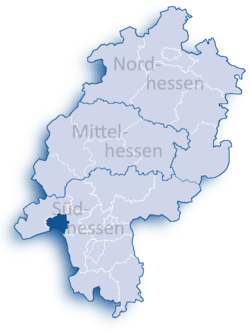
Back Wiesbaden Afrikaans Wiesbaden ALS ቪስባድን Amharic Wiesbaden AN فيسبادن Arabic ڤيسبادين ARZ Wiesbaden AST Wiesbaden Aymara Visbaden Azerbaijani ویسبادن AZB
Wiesbaden | |
|---|---|
| Coordinates: 50°04′57″N 08°14′24″E / 50.08250°N 8.24000°E | |
| Country | Germany |
| State | Hesse |
| Admin. region | Darmstadt |
| District | Urban district |
| Founded | 121 |
| Subdivisions | 26 boroughs |
| Government | |
| • Lord mayor (2019–25) | Gert-Uwe Mende[1] (SPD) |
| • Governing parties | CDU / SPD |
| Area | |
| • Total | 203.9 km2 (78.7 sq mi) |
| Elevation | 115 m (377 ft) |
| Population (2022-12-31)[2] | |
| • Total | 283,083 |
| • Density | 1,400/km2 (3,600/sq mi) |
| Time zone | UTC+01:00 (CET) |
| • Summer (DST) | UTC+02:00 (CEST) |
| Postal codes | 65183–65207 55246 (Mainz-Kostheim) 55252 (Mainz-Kastel) |
| Dialling codes | 0611, 06122, 06127, 06134 |
| Vehicle registration | WI |
| Website | wiesbaden.de |

Wiesbaden (German pronunciation: [ˈviːsˌbaːdn̩] ; lit. 'meadow baths') is the capital of the German state of Hesse, and the second-largest Hessian city after Frankfurt am Main. With around 283,000 inhabitants, it is Germany's 24th-largest city. Wiesbaden forms a conurbation with a population of around 500,000 with the neighbouring city of Mainz. This conurbation is in turn embedded in the Rhine-Main Metropolitan Region—Germany's second-largest metropolitan region after Rhine-Ruhr—which also includes the nearby cities of Frankfurt am Main, Darmstadt, Offenbach am Main, and Hanau, and has a combined population exceeding 5.8 million.
The city is located on the Rhine (Upper Rhine), at the foothills of the Taunus, opposite the Rhineland-Palatine capital of Mainz, and the city centre is located in the wide valley of the small Salzbach stream. Wiesbaden lies in the Rheingau wine-growing region, one of Germany's 13 wine regions. Three of Wiesbaden's boroughs were part of the city of Mainz until 1945, and still bear the designation "Mainz" in their names—the so-called AKK-boroughs of Mainz-Amöneburg, Mainz-Kastel, and Mainz-Kostheim. This so-called AKK-Konflikt (de:AKK-Konflikt) is the main cause for the rivalry between Mainz and Wiesbaden. Wiesbaden Main Station is connected to Frankfurt am Main by the Rhine-Main S-Bahn rapid transit system.
Historically, Wiesbaden was a Nassauian city. From 1170 to 1629, it lay in the County of Nassau, and from 1629 to 1721, it was in the county and later principality of Nassau-Idstein, all of which were territories within the Holy Roman Empire ruled by branches of the House of Nassau. In 1728, the city found itself in the principality of Nassau-Usingen, and in 1744, Biebrich Palace became the main residence of the House of Nassau-Usingen. In 1806, the city became the capital of the Duchy of Nassau. Since 1841, the newly built Wiesbaden City Palace was the principal Nassauian residence. From 1868 to 1944, the city lay in the Prussian Province of Hesse-Nassau, and from 1944 to 1945, it was the capital of the Province of Nassau. In 1945, it became the capital of Greater Hesse and subsequently, in 1946, of Hesse.
Wiesbaden is one of the oldest spa towns in Europe. Its name translates to "meadow baths", and there are 15 mineral springs—14 of which are hot springs—in the city centre.[3] With a yield of around 2 million liters daily, Wiesbaden is the second-most productive German spa after Aachen. Its location in a mountain basin at the southern foot of the Taunus, protected by the mountains in the north and west, gives Wiesbaden a mild climate. It has been called the "Nice of the North" because of its climate and architecture.[4] The city of Wiesbaden is one of the wealthiest cities in Germany and one of those with above-average purchasing power.[5] The United States Army Europe and Africa headquarters are located in Wiesbaden-Erbenheim.
- ^ "Ergebnisse der letzten Direktwahl aller hessischen Landkreise und Gemeinden" (XLS) (in German). Hessisches Statistisches Landesamt. 5 September 2022. Archived from the original on 13 November 2022. Retrieved 11 November 2022.
- ^ "Bevölkerung in Hessen am 31.12.2022 nach Gemeinden" (XLS) (in German). Hessisches Statistisches Landesamt. June 2023.
- ^ Wiesbadener Tagblatt. 18 September 2008
- ^ Heinrich-Verlag GmBH (2011). Wiesbaden: For Old Friends and New. Heinrich-Verlag GmBH. p. 4. ISBN 978-3-89889-167-7.
- ^ "Kaufkraft 2017" (PDF). IHK Wiesbaden. Archived from the original (PDF) on 25 August 2017. Retrieved 24 August 2017.











